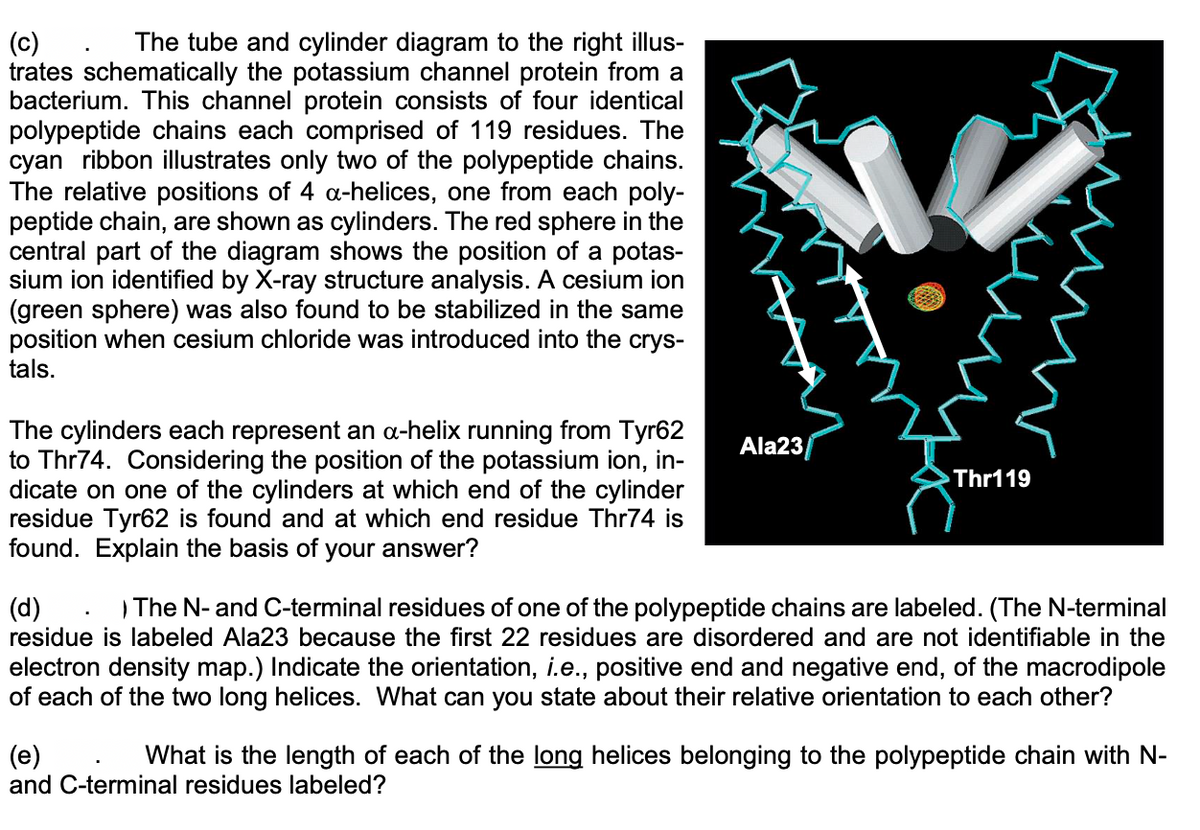(c) The tube and cylinder diagram to the right illus- trates schematically the potassium channel protein from a bacterium. This channel protein consists of four identical polypeptide chains each comprised of 119 residues. The cyan ribbon illustrates only two of the polypeptide chains. The relative positions of 4 α-helices, one from each poly- peptide chain, are shown as cylinders. The red sphere in the central part of the diagram shows the position of a potas- sium ion identified by X-ray structure analysis. A cesium ion (green sphere) was also found to be stabilized in the same position when cesium chloride was introduced into the crys- tals. The cylinders each represent an α-helix running from Tyr62 to Thr74. Considering the position of the potassium ion, in- dicate on one of the cylinders at which end of the cylinder residue Tyr62 is found and at which end residue Thr74 is found. Explain the basis of your answer? Ala23 Thr119 (d) The N- and C-terminal residues of one of the polypeptide chains are labeled. (The N-terminal residue is labeled Ala23 because the first 22 residues are disordered and are not identifiable in the electron density map.) Indicate the orientation, i.e., positive end and negative end, of the macrodipole of each of the two long helices. What can you state about their relative orientation to each other? (e) What is the length of each of the long helices belonging to the polypeptide chain with N- and C-terminal residues labeled?
(c) The tube and cylinder diagram to the right illus- trates schematically the potassium channel protein from a bacterium. This channel protein consists of four identical polypeptide chains each comprised of 119 residues. The cyan ribbon illustrates only two of the polypeptide chains. The relative positions of 4 α-helices, one from each poly- peptide chain, are shown as cylinders. The red sphere in the central part of the diagram shows the position of a potas- sium ion identified by X-ray structure analysis. A cesium ion (green sphere) was also found to be stabilized in the same position when cesium chloride was introduced into the crys- tals. The cylinders each represent an α-helix running from Tyr62 to Thr74. Considering the position of the potassium ion, in- dicate on one of the cylinders at which end of the cylinder residue Tyr62 is found and at which end residue Thr74 is found. Explain the basis of your answer? Ala23 Thr119 (d) The N- and C-terminal residues of one of the polypeptide chains are labeled. (The N-terminal residue is labeled Ala23 because the first 22 residues are disordered and are not identifiable in the electron density map.) Indicate the orientation, i.e., positive end and negative end, of the macrodipole of each of the two long helices. What can you state about their relative orientation to each other? (e) What is the length of each of the long helices belonging to the polypeptide chain with N- and C-terminal residues labeled?
Biochemistry
9th Edition
ISBN:9781319114671
Author:Lubert Stryer, Jeremy M. Berg, John L. Tymoczko, Gregory J. Gatto Jr.
Publisher:Lubert Stryer, Jeremy M. Berg, John L. Tymoczko, Gregory J. Gatto Jr.
Chapter1: Biochemistry: An Evolving Science
Section: Chapter Questions
Problem 1P
Related questions
Question

Transcribed Image Text:(c)
The tube and cylinder diagram to the right illus-
trates schematically the potassium channel protein from a
bacterium. This channel protein consists of four identical
polypeptide chains each comprised of 119 residues. The
cyan ribbon illustrates only two of the polypeptide chains.
The relative positions of 4 α-helices, one from each poly-
peptide chain, are shown as cylinders. The red sphere in the
central part of the diagram shows the position of a potas-
sium ion identified by X-ray structure analysis. A cesium ion
(green sphere) was also found to be stabilized in the same
position when cesium chloride was introduced into the crys-
tals.
The cylinders each represent an α-helix running from Tyr62
to Thr74. Considering the position of the potassium ion, in-
dicate on one of the cylinders at which end of the cylinder
residue Tyr62 is found and at which end residue Thr74 is
found. Explain the basis of your answer?
Ala23
Thr119
(d)
The N- and C-terminal residues of one of the polypeptide chains are labeled. (The N-terminal
residue is labeled Ala23 because the first 22 residues are disordered and are not identifiable in the
electron density map.) Indicate the orientation, i.e., positive end and negative end, of the macrodipole
of each of the two long helices. What can you state about their relative orientation to each other?
(e)
What is the length of each of the long helices belonging to the polypeptide chain with N-
and C-terminal residues labeled?
Expert Solution
This question has been solved!
Explore an expertly crafted, step-by-step solution for a thorough understanding of key concepts.
Step by step
Solved in 1 steps

Recommended textbooks for you

Biochemistry
Biochemistry
ISBN:
9781319114671
Author:
Lubert Stryer, Jeremy M. Berg, John L. Tymoczko, Gregory J. Gatto Jr.
Publisher:
W. H. Freeman

Lehninger Principles of Biochemistry
Biochemistry
ISBN:
9781464126116
Author:
David L. Nelson, Michael M. Cox
Publisher:
W. H. Freeman

Fundamentals of Biochemistry: Life at the Molecul…
Biochemistry
ISBN:
9781118918401
Author:
Donald Voet, Judith G. Voet, Charlotte W. Pratt
Publisher:
WILEY

Biochemistry
Biochemistry
ISBN:
9781319114671
Author:
Lubert Stryer, Jeremy M. Berg, John L. Tymoczko, Gregory J. Gatto Jr.
Publisher:
W. H. Freeman

Lehninger Principles of Biochemistry
Biochemistry
ISBN:
9781464126116
Author:
David L. Nelson, Michael M. Cox
Publisher:
W. H. Freeman

Fundamentals of Biochemistry: Life at the Molecul…
Biochemistry
ISBN:
9781118918401
Author:
Donald Voet, Judith G. Voet, Charlotte W. Pratt
Publisher:
WILEY

Biochemistry
Biochemistry
ISBN:
9781305961135
Author:
Mary K. Campbell, Shawn O. Farrell, Owen M. McDougal
Publisher:
Cengage Learning

Biochemistry
Biochemistry
ISBN:
9781305577206
Author:
Reginald H. Garrett, Charles M. Grisham
Publisher:
Cengage Learning

Fundamentals of General, Organic, and Biological …
Biochemistry
ISBN:
9780134015187
Author:
John E. McMurry, David S. Ballantine, Carl A. Hoeger, Virginia E. Peterson
Publisher:
PEARSON